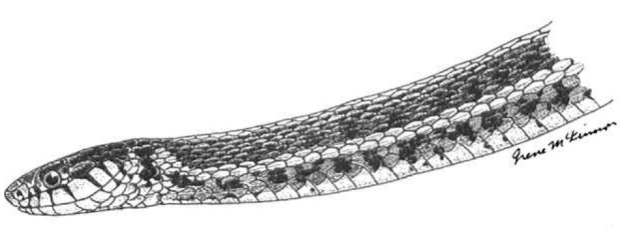Plains Garter Snake. Thamnophis radix
Description: A medium-sized, slender, elongate snake attaining a total length of 500-1,000 mm. There are usually seven upper labial scales, and two pairs of chin shields, the posterior pair being longer and narrower from the anterior. The dorsal scales are keeled, there are normally twenty-one scale rows at mid-body and the anal scale is single. The tail is moderately long. Background colour is greenish grey, olive or brownish, with two rows of dark blotches forming a checkered pattern between the dorsal and lateral stripes. The dorsal stripe is usually orange to yellow, fading posteriorly. The lateral stripes are normally yellowish and are located on the third and fourth dorsal scale rows. Black bars are present on the yellowish upper labial scales. The ventral colour is variable and may be whitish, bluish green, or grey, with two rows of dark, diffuse spots.

Variation: Females are larger than males.
Natural history: This species has very wide habitat preferences and tolerances. It frequents ponds, lakes, streams, marshes and dugouts. It preys upon fish, amphibians, small mammals, worms, insects and carion. It possesses cloacal glands that secrete a foul- smelling liquid. If captured it may writhe and twist in an attempt to escape, but it rarely bites. It smears the secretions of the cloacal glands on the attacker, together with faeces. It may still be found in urban areas if suitable habitat persists. It may be active until mid-October on warm days. Like its congeners, this species uses hibernacula such as natural karst sink holes, mammal burrows and rock piles. It is mildly venomous and may immobilize its prey by injection of oral secretions. These secretions have no effect on man.

Reproduction: Mating may take place in spring or fall and is associated with denning congregations. It is a live-bearing species and may be very prolific, with from five to forty young being produced in a normal litter. On occasion, as many as ninety-two young have been produced in a single birth. The young are born from July onwards, and are about 180 mm in total length.
Distribution: In Alberta, the plains garter snake is widely distributed south of Cold Lake, primarily in the eastern half of the province. It inhabits short-grass prairie, aspen parkland and, marginally, boreal forest. It occurs as far west as Calgary, with a few records from subalpine areas near the B.C. border. Its range overlaps with those of Thamnophis elegans and T. sirtalis in south central Alberta. It is most common in the southeastern corner of the province. Extralimitally, it is found east through Saskatchewan and Manitoba, south through the great plains and upper midwestern United States from northeastern New Mexico to northwestern Indiana. Isolated populations occur in Ohio, the St. Louis area and northwestern Arkansas.
Conservation status: This species remains common in southeastern Alberta but populations around Calgary appear to have under-gone decline.
Remarks: Two subspecies are recognized. Thamnophis radix haydeni occurs in Alberta. Its range extends to Minnesota, central Iowa, northwestern Missouri and Kansas. An outlier occurs in the Ozark Mountains.
Significant references: Arnold and Bennett 1984, 1988; Ballinger et al. 1979; Bauerle 1972; Bullock and Tanner 1966; Chiszar et al. 1976; Dalrymple and Reichenbach 1981; Gregory 1977a; Mutschmann 1995; Hart 1975,1979; Ross and Crews 1977, 1978; Rossman et al. 1996; Ruthven 1908; Seibert, 1950; Smith 1949; Stewart 1965; Sweeney 1992; Van Denburgh and Slevin 1918.
Date added: 2022-12-11; views: 635;
